|
|||||||||
|
FEATURESWhen Is a Wall a Great Wall?The enormous time span during which the construction of walls and barriers took place ensures that few historians have attempted or been able to apply a single model, whether drawn from military history, diplomatic history, ethnic history, economic history, environmental history or even architectural history, to the history of China's Great Walls (changcheng, literally 'long wall(s)'). Moreover, while the Great Walls can be defined in the first instance as a set of structures of largely military significance, scholars disagree regarding the geographical extent of the military system in which the walls are the most tangible element. The literature on the Great Walls continues to swell and archaeologists continue to identify new sections of wall that previously went undocumented. We examine three interesting recent additions to the Great Walls files, although none have yet gained general acceptance from scholars: a cave settlement below a beacon tower north of Beijing; an adobe rampart built by the Xibe garrison near China's border with Kazakhstan; and a fort and set of walls constructed by General Yue Fei (1103-1141) of the Southern Song dynasty. Many scholars feel that not all ancient Chinese military walls and defensive structures qualify for consideration as 'Great Walls'. The Yanqing Caves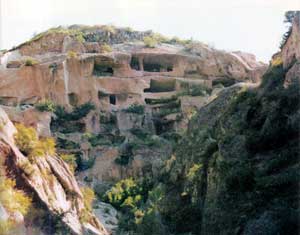 Fig. 1 Man-made caves in the north-western mountains of Yanqing county, Beijing municipality, described in the caption to this photograph in The Great Wall Encyclopaedia as 'dwellings inherited by the Xi nationality from the Murong and Wuhuan peoples'. The 'ancient man-made cliff dwellings' in Yanqing county, Beijing, came to public attention only in the 1980s, and have attracted speculation ever since. The existence of the man-made caves with carved benches and potential working surfaces had remained a locally guarded secret of the nearby villagers, for whom the caves had served as hideouts from the depredations of bandits and the Japanese. (Fig. 1) When evidence of ancient occupation came to light, the warren of caves was examined by local archaeologists. Nine of the caves had clearly once served as horse stables. One of the most plausible suggestions advanced by archaeologists was that the caves had been occupied by an ancient ethnic group, the Western Xi. The nomadic Xi emerge on the pages of Chinese histories in the Sui-Tang period (581-907 CE), and, like the Khitan, they were a branch of the Yuwen group of the Xianbei (Hsien-p'i) people from north-eastern China. Geographically, they inhabited an area north of the traditional line of Han Great Walls between the lands occupied by Turks to the west and by the Khitan people to the east. To avoid enslavement by the Khitan, one large group of Xi migrated southwards in the 8th century and took shelter in the area around Huairou county in Beijing, while a second group moved into the mountains beyond the Gubeikou pass of the Great Wall. From the 8th century onwards, the nomadic Xi were split into western and eastern groups. After the rise of the Khitan under Abaoji (872-926), who came to be given the posthumous title Liao Taizu, both Xi groups were finally enslaved and through the use of the Xi as farmers, the Khitan effected their rise to a more settled existence, emerging as the Liao dynasty (907-1125) in Chinese history. The Xi were thereafter assimilated into the Liao nation. Apart from the fact that the Xi sought refuge in the Taihang cordillera that straddles the area in the north of today's Beijing municipality, including Yanqing county, we have very little information regarding their material culture and only Khitan agricultural implements can provide clues. There is certainly no material evidence for this archaeological speculation. Another theory regarding the identity of the original Yanqing cave dwellers was recently advanced by archaeologist Yang Hongxun, whose area of expertise is ancient Chinese architecture. Yang argues that the theory that the caves were hewn out by the Xi people is unsupportable. The nomadic Xi would have had large herds of horses, and Yang points out that nine cave stables would have been inadequate for the needs of even a small nomadic tribe. Yang Hongxun believes that the clues regarding the true nature of the man-made caves at Yanqing can be found in an entry for the Shiyu river in the remarkable ancient geographical reference work, Li Daoyuan's Shui jing zhu (The annotated classic of the rivers), compiled in the 6th century. A note on that entry explains that on 'the eastern cliffs of a gorge', somewhere between Yanqing and Huairou counties, 'there were three layers of stone cave rooms'. Yang believes this passage refers to the man-made caves at Yanqing. Li Daoyuan writes that at this site these were 'beacon towers standing guard over an ancient pass' (guguan zhi houtai). Yang Hongxun interprets this is a reference to the many beacon platforms that surrounded Juyong Pass in the Han dynasty. Li Daoyuan was writing in the Northern Wei (386-534) dynasty, when the Han dynasty's defences around Juyong Pass had fallen into disuse, and Yang suggests that this is why Li writes of 'an ancient pass'. 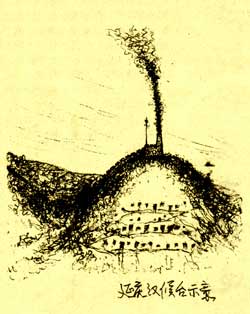 Fig. 2 Han dynasty beacon tower (houtai) and adjacent cave encampment in Yanqing, Beijing municipality. (Source: Sketch by Yang Hongxun in Zhongguo wenwu bao, 7 April 2006, p.7) Some of the Han dynasty inscribed wooden slips unearthed at Juyan in Gansu province provide a fairly precise account of the organisation of these beacon-towers and the terminology used to delineate their hierarchy. From these sources, a Han dynasty houtai is best described as a military camp at a beacon platform, which was provided with stores, firewood, an office, relay horses and accommodation for a small platoon. Yang Hongxun writes that he found the remains of the beacon tower on the summit of the cliffs in which the cave dwellings were carved out. (Fig. 2) Although there are only a few hand-cut rocks there today, in discussions with elderly villagers he was told that there had been many rocks at the summit fifty years ago. One of the childhood past-times of villagers had been hurling the piled up rocks from the top of the cliff into the valley below, to compare the echoing sounds they made. Two residents, today in their seventies, told him that when they were children, there were many rocks at the summit. These had been squared off and formed part of a wall at least one metre in height. One elderly man told him that their village, Dongyingcun (lit., 'Eastern Barracks Village') had been founded in the Ming dynasty, and children had probably played on this spot throughout the four centuries since then. Yang remains convinced that over these four centuries all traces of the earlier beacon platform were erased. The mystery of the man-made caves at Yanqing may never be solved, but a tentative chapter has been added to the history of the Great Walls. The Great Walls of the XibeThe fertile Ili Valley in far north-western Xinjiang has witnessed some of the most spectacular migrations of ethnic groups in Chinese history. Two occurred in the Qing dynasty, as part of the Great Game played out by the converging Russian and Manchu empires. The best known is the return to their homelands of the Torghut Mongols, also known as the Kalmyks, from the banks of the Volga. Their odyssey is well documented by historians, and it even captured the imagination of the 19th century Irish writer Thomas de Quincey who described this epic journey in Revolt of the Tartars. This Mongol group arrived in Ili on the Qing border in 1771, and some of their descendants still live in the Ili district today. Their leaders were eventually welcomed back to the fold of the Qing nation in Jehol (Rehe, present-day Chengde in Hebei) by the Qianlong Emperor with great pomp and ceremony. Less well known is the migration to the Ili River Valley of the Xibe people from China's north-east. The Xibe—variously written Sibe, Sibo, Xibo or Xibe, are closely related to the Manchus. Today they number less than 200,000, but many serve as translators in the Qing archives in Beijing because of the close similarity of their language to Manchu. Most Chinese ethnologists regard the Xibe as descendants of the Xianbei people. Originally resident in the Greater Khingan mountains of northern Heilongjiang, they moved southwards in the 17th century, in the face of Russian encroachment, and became assimilated within the Eight Banner system. In 1699, the Kangxi Emperor relocated them to the area of Liaoning province just north of the Great Wall. In the wake of the suppression of the Mongol and Muslim uprisings in Zhungaria and other parts of what is today Xinjiang, the Qianlong Emperor assigned the Xibe in 1764 to garrison duty in the Ili River Valley, at the far western frontier of his empire. An expedition of Xibe warriors and their families, totally 3,275 persons, duly made the epic journey across the grasslands and deserts of Mongolia that took one year and five months to complete. Under the leadership of their leader, Tubot, remembered today as a culture hero by the Xibe of the Chapqal Xibe Autonomous County outside Yining, the Xibe engaged in irrigating the inferior farming lands to which they were assigned. 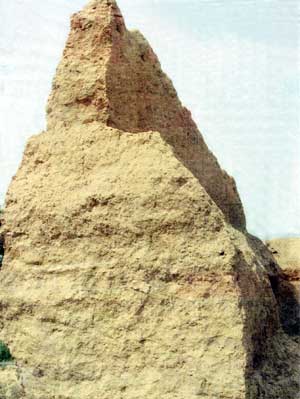 Fig. 3 Photograph of the only surviving kalun in Chapqal county near Yining, Xinjiang. The resettlement of the Xibe warriors and their families as a farming garrison was an example of the Qing rulers' emulation of a military policy, called the tuntian system in Chinese, first practised by the Han dynasty and later by many other Chinese dynasties, as a means of securing the country's border with walls and barricades manned by troops forced to learn the virtues of self-sufficiency. The Qing emperors also encouraged Manchu and Mongol Bannermen, whom they were felt were adopting profligate Han ways, to set up military garrisons in the north-west. The Qing rulers were, of course, less concerned with the agricultural welfare and irrigation works of the Xibe of Chapqal than with their ability to guarantee the security of China's borders. To satisfy their overlords, the Xibe constructed tall forts made from adobe. Called kalun, these structures pleased the Manchu military planners, although the Xibe regarded them as important protection for their irrigation canals and fields. Each kalun was protected by a ditch on its outside, and from the ground it rose at least 4m in height. A rampart at the top was provided by merlons through which the ground below could be observed. A network of least 18 of these forts guarded the Chapqal area, but most were destroyed during warfare in the 19th century. Only one well-preserved example remains today, and it can be seen in the farmlands of the 7th company of the 67th regiment of the People's Liberation Army's Production and Construction Force stationed in Chapqal county. (Fig. 3) The kalun of the Ili River Valley might not be regarded as a part of China's history of Great Walls, but they were certainly part of the country's history of border security, many being levelled in the battles to maintain it. The Great Walls of Yue Fei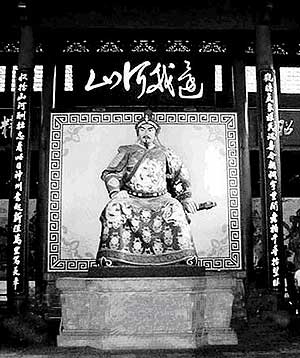 Fig. 4 Statue of Yue Fei from the Yuewang Miao temple on the shores of the West Lake in Hangzhou. The plaque above the statue reads from right to left: 'Huan wo heshan' (Restore our rivers and mountains). The statue was sculpted in 1979 by students of the Zhejiang Meishu Xueyuan (now named the Zhongguo Meishu Xueyuan) in Hangzhou. The sculpture has been the brunt of much criticism in the media, because of the failure to incorporate any of the features of Yue Fei as described in textual records. The hands are also grossly exaggerated. An online discussion of the sculpture appears at: http://news.tom.com/1002/20040804-1161722.html 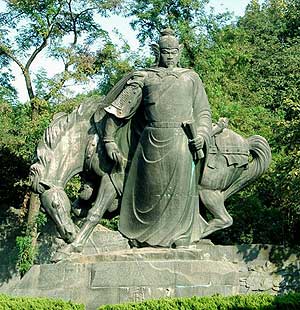 Fig. 5 Bronze statue of Yue Fei from the park at Donghu (East Lake), Wuhan, Hubei province. This 8m-high work was completed by 'the people of Wuhan' (Wuhan renmin) in 1993. Zhan Xueqi, in an article in the 11 April 1999 issue of China Cultural Relics News (p. 4), identified a military wall in Jihong, a town in northern Hubei located close to the border with Henan province, as a small 'Great Wall'. The rampart, constructed on the ridge of Zhulian hill, was the remains of a protective wall constructed in the Southern Song dynasty when Yue Fei (1103-1141) and his troops were fighting the Jurchen (Nüzhen) in this region. The Jurchen had already established their Jin dynasty in northern China in 1115 and had vanquished the Northern Song, sacking their capital Kaifeng, in 1127. The association with Yue Fei is fortuitous. (Figs. 4 & 5) The general became a national hero and secured many victories over the Jurchen for more than a decade. However, he was finally executed as a traitor in 1141 as a result of charges trumped up by the Southern Song prime minister Qin Hui (1086-1151). Twenty years later, his reputation was rehabilitated and a cult developed around his memory. Countless temples were constructed to honour him, especially in the 19th century and again during the Japanese invasion in the 20th century. By bringing together Yue Fei and the Great Wall, Zhan was effectively welding together two national icons. The wall built by Yue Fei's men is, at its greatest width, nearly 2m thick and some sections are still nearly 2m in height. Archaeologists also discovered a barracks adjacent to the wall, consisting of more than 60 rooms and also built by Yue Fei's troops. Along one side of the barracks, described by Zhan as a supplementary structure to the 'Great Wall', is an enclosing wall measuring 1,000m in length. Zhan also describes this Song dynasty 'Great Wall' as marking the frontier between the Jing and Chu regions. Such a fortification, like the Yanqing beacon and the Chapqal lookout post, is not regarded by some scholars as a 'Great Wall', simply because it is isolated and not part of any larger military structural system, at least not one presently identified. Many scholars, such as Jing Ai, are opposed to all these new claims by proponents of the recognition of previously unknown Great Walls. However, there has also been resistance to the views of Jing Ai who 'has decried the inclusion of every rampart, bulwark, willow palisade, stockade, fortress, trench, pit and moat that constitute the limes of ancient dynasties as part of the Great Wall',[1] and has even argued, in the face of much opposition, that the Jin dynasty's system of trenches (bianhao) did not qualify as Great Wall structures.[2] However, there is a steady stream of reports of discoveries of new 'Great Walls' in the Chinese media, especially emanating from the south of the China. [BGD] Notes[1] Jing Ai, China Cultural Relics News, 30 January 2004, p. 8. See also 'The Great Wall of China: Tangible, Intangible and Destructible', in China Heritage Newsletter, No.1 (March 2006) under Features. http://www.chinaheritagenewsletter.org/features.php?searchterm=001_greatwall.inc&issue=001 [2] Jing Ai, idem. |